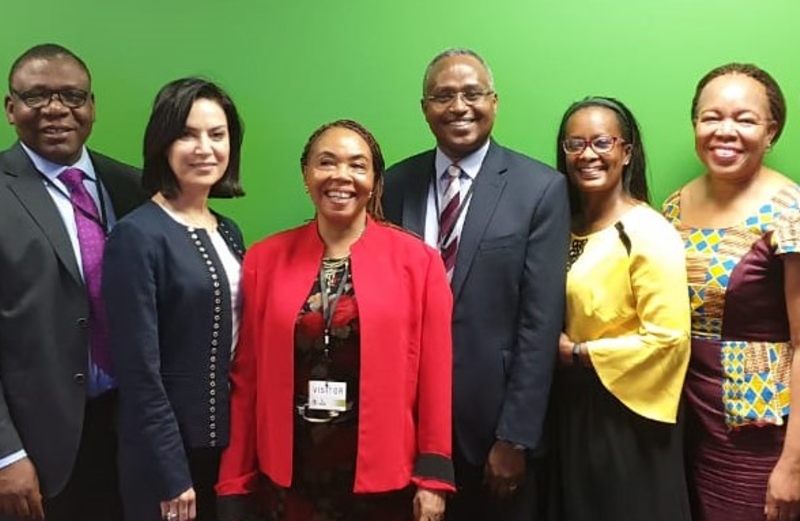AUDA-NEPAD and WHO, joint secretariat of the African Medicines Regulatory Harmonisation Initiative

The World Health Organisation (WHO) and the African Union Development Agency-NEPAD (AUDA-NEPAD) teams met in Midrand, South Africa from 11-12 February 2019. The purpose of the meeting was to agree on modalities of collaborative work as joint secretariat to the African Medicines Regulatory Harmonisation (AMRH) Initiative. The two teams which were led by Dr Mike Ward, Coordinator, Regulatory Systems Strengthening, Department of Essential Medicines and Health Products at WHO Headquarters in Geneva, and Mrs Margareth Ndomondo-Sigonda, Head of Health Programs including the African Medicines Regulatory Harmonisation Initiative, from AUDA-NEPAD, discussed among others; terms of reference of the Joint Secretariat including roles and responsibilities of the two organisations in executing their respective mandates. The meeting marks a critical milestone for AMRH, a decade after its inception in February 2009.
The AMRH Initiative was established in 2009 as a platform for building and strengthening regulatory capacity through harmonisation of regulatory guidelines and standards by working with national medicines regulatory agencies (NMRAs) and their respective regional economic communities (RECs). The AMRH is composed of representatives from NMRAs, RECs, AU Commission, Pan African Parliament, WHO, AUDA-NEPAD, Bill & Melinda Gates Foundation, UK’s Department for International Development (DFID), US Government, GAVI, Swissmedic, Swiss Development Cooperation, and the World Bank.
In the regions where AMRH has been implemented, harmonised regulatory technical requirements and procedures have been agreed, and are in use both at regional and national levels. Collaboration and work-sharing have also resulted in improvements in individual NMRAs’ technical capacities as evidenced in the East African Community (EAC) by maturity level progression across two WHO benchmarking exercises in 2016 and 2018.
The marketing authorisation review timelines in the EAC and the Southern African Development Community (SADC) region have dropped by approximately 50%. More than 100 products have been recommended for registration in the Zazibona Scheme in the SADC region, and 13 in the EAC region following joint assessments which began in 2013 and 2015, respectively. Joint dossier reviews have been initiated in the Economic Community of African States (ECOWAS) through the West African Health Organisation (WAHO) and Western African Economic and Monetary Union (WAEMU) Joint Secretariat. Similar work is underway in the Central and the Horn of Africa through the Organisation of Coordination for the Fight against Endemic Diseases in Central Africa (OCEAC) and the Intergovernmental Authority on Development (IGAD), respectively.
In recognition of the need to strengthen the capacity for regulation of medical products in Africa, and the harmonisation of medicines regulatory systems as a foundation for the establishment of a single regulatory Agency for Africa within the framework of the Pharmaceutical Manufacturing Plan for Africa (PMPA); the AU Executive Council through its Decision {EX.CL/Dec.857 (XXVI)} of January 2015 endorsed the establishment of the African Medicines Agency (AMA). The Executive Council further requested the AUC, AUDA-NEPAD and the WHO in collaboration with other stakeholders to define the scope of the medical products and regulatory functions that would be covered by the work of the AMA, and to work out detailed modalities, institutional framework, legal and financial implications, of the establishment of the AMA.
In view of these developments and taking into account the AU executive Council Decision, the AMRH Partners agreed in February 2017 to review the governance structure to ensure effective and efficient delivery while maintaining country ownership and leadership. This includes reviewing and assigning roles of various governance entities such as the African Medicines Regulators Conference (AMRC) as the Assembly for AMRH; the AMRH Steering Committee, the continental Technical Working Groups (TWGs) and the Secretariat to coordinate activities on a daily basis. A new AMRH Partnership Platform (AMRH-PP) has been established to provide financial, technical and policy advocacy support at the various levels of the AMRH Governance structure.
The AMRH Secretariat meeting in Midrand, South Africa therefore serves as a critical step in operationalising the new AMRH Governance Framework. This is also a timely development taking into account the endorsement by the AU Assembly, of the Treaty for establishment of the AMA on 11th February 2019.
Key outputs of the AMRH Secretariat meeting include;
- Agreed roles and responsibilities of both WHO and AUDA-NEPAD Agency as a Joint Secretariat;
- Finalised model terms of reference for continental TWGs;
- Establishment of criteria for inclusion of new members to the AMRH-PP;
- Finalised AMRH Monitoring and Evaluation Framework;
- Key milestones for smooth transitioning of AMRH activities into AMA (2019-2023);
- A resource mobilisation strategy to ensure sustainability of AMRH-AMA in the “post-donor” period.
As a result, these achievements will be presented to the AMRH Steering Committee meeting in March 2019 and eventually to the AMRC Assembly in October 2019, for approval. Once agreed amongst regulators on the continent, the documents will then be tabled before the AU Policy Organs for final endorsement.
These collective efforts of the AMRH Secretariat are geared towards implementation of the AU Agenda 2063 Vision of “building an integrated, prosperous and peaceful Africa, driven by its own Citizens and representing a dynamic force in the international arena”.
Approved by AUDA-NEPAD & WHO for release on 18 February 2019


